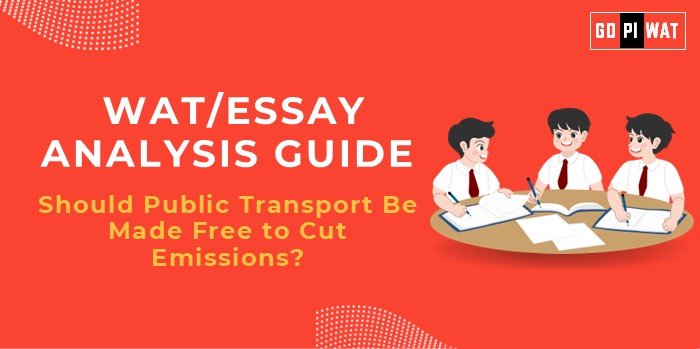🚌 Written Ability Test (WAT) Analysis Guide: “Should Public Transport Be Made Free to Cut Emissions?”
🌍 Understanding the Topic’s Importance
Context: Public transport’s role in cutting emissions aligns with the global push towards net-zero goals. The topic’s significance is heightened by urbanization and the ongoing climate crisis.
🕒 Effective Planning and Writing
- Time Allocation:
- Reading & Planning: 5 minutes.
- Writing: 20 minutes.
- Review: 5 minutes.
- Preparation Tips:
- Collect verified data (e.g., transport emissions, free transport case studies).
- Identify stakeholders and expected outcomes.
✍️ Introduction Techniques for Essays
- Contrast Approach: “While urban emissions remain a leading contributor to climate change, many cities experiment with free public transport to address this crisis.”
- Solution-Based Approach: “Making public transport free offers a compelling pathway to cut emissions, but it poses economic and operational challenges.”
📖 Structuring the Essay Body
- Achievements:
- Emission reduction examples from Luxembourg and Tallinn.
- Enhanced mobility for low-income groups.
- Challenges with Comparative Analysis:
- Funding deficits and alternative solutions like congestion pricing.
- Overcrowding issues and strategies to mitigate them.
- Future Outlook:
- Integration with smart transport technologies.
- Policy innovations like partial subsidies.
✅ Concluding Effectively
- Balanced Perspective: “Free public transport, while promising, must balance environmental benefits with fiscal feasibility.”
- Global Comparison: “Cities must adapt global successes like Estonia’s to their unique contexts for impactful outcomes.”
📊 Analyzing Successes and Shortcomings
- Key Achievements: Emission cuts, congestion mitigation, equitable access.
- Ongoing Challenges: Financial strain, overcrowding, rural exclusions.
- Global Context: Tallinn and Luxembourg successes.
💡 Recommendations for Sustainable Progress
- Phased implementation focusing on urban centers.
- Funding through congestion taxes and international climate finance.
- Technology integration to enhance efficiency.
📝 Sample Short Essays
- Balanced Perspective: “Free public transport, by reducing emissions and promoting equity, addresses urban challenges but demands economic prudence and scalability.”
- Solution-Oriented: “By coupling free public transport with carbon taxes, cities can achieve environmental goals without financial burdens.”
- Global Comparison: “Estonia and Luxembourg exemplify the benefits of free public transport, a model worth emulating with local adaptations.”


